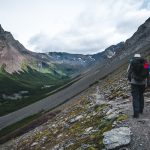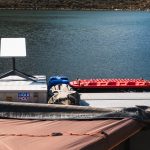Chiloé Island – this is the archipelago of fishermen and shellfish gatherers, home to shingle carvers and potato farmers, as we read in the guidebook. Between the lush green, gently rolling hills graze horses and cows. It is an idyllic patch of land, characterized by gently undulating hills and the friendliness of its inhabitants.
For one week, we travel back and forth across the island and its smaller neighboring islands, enjoying nature and visiting the churches for which Chiloé is so famous.
Chiloé Island – Background Information
With 8,500 km², Chiloé is the second-largest island in South America after Tierra del Fuego. It is essentially a submerged, sea-covered mountain range, a result of melting glaciers.
On the island of Chiloé itself, there is little industry. As a result, many of the approximately 150,000 residents commute regularly to Puerto Montt, the nearest city on the mainland.
The Churches of Chiloé
The wooden churches of Chiloé, mostly built from cypress wood in the 17th and 18th centuries, are a remarkable part of Chile's cultural heritage. Since 2000, 16 of these churches have been designated as UNESCO World Heritage sites.
The indigenous peoples of Chiloé, the Mapuche and Chono, witnessed the Spanish conquest of the island in 1567. The Jesuits arrived in 1608 and began building churches, with the first one completed in 1612. Today, 150 wooden churches remain, often painted in vibrant colors, with their interiors also frequently adorned in bright hues.
An overview of the 16 UNESCO World Heritage churches:
- Castro Municipality Castro, Rilán, Nercón and Chelín
- Chonchi Municipality: Chonchi and Vilupuili
- Quemchi Municipality: Colo
- Dalcahue Municipality: Dalcahue, Tenaún and San Juan
- Island Quinchao: Quinchao and Achao
- Island Caguach: Caguach
- Island Lemuy: Aldachildo, Ichuac and Detif

The potatoe and Chiloé
By the way, Chiloé, along with Peru, is considered one of the possible original homelands of the potato. The "Papas Nativas" can be found not only at markets but also in local supermarkets. Today, around two hundred varieties of potatoes are still grown on Chiloé. These are not grown as pure varieties but, as for centuries, are cultivated as a mix.
Castro – The Island's Capital
With 41,500 inhabitants, Castro is the largest city on Chiloé and the starting point of our road trip on the island. The city features a lovely Plaza de Armas with the citrus-yellow Iglesia de San Francisco, which, however, is not typically Chilotian.

Castro is especially famous for its Palafitos, the stilt houses. These colorful buildings are particularly found in the western neighborhood of Barrio Gamboa by the Fiordo de Castro bay and in the northeastern part of the city along the coastal road, Calle Pedro Montt. While the houses stand on stilts towards the water, they rest on solid walls facing the street. The Palafitos were invented in the 19th century to facilitate life near the shore, providing enough space underneath for boats.
From Chaitén, we reach Castro by car ferry. The crossing takes about 5 hours. Since the ferry departs early, we didn’t have time for breakfast. The sandwiches on the ferry are not great, so we decide to go out for lunch once we arrive in Castro.
We find a restaurant in one of the Palafitos and order the traditional Chilotian dish, Curanto. In this traditional preparation, stones are first heated in a pit. Then, ingredients such as potatoes, seafood, meat, and vegetables are layered on Nalca or Pangue leaves and covered with additional leaves.
When our order arrives, we receive two huge portions of Curanto. Overwhelmed, we start with one portion, and even that is nearly too much for both of us. Feeling a bit embarrassed with the enormous amounts of food, we think that the staff could have warned us. After about 10 minutes, the owner comes by and asks if we would like to return one portion. Relieved and grateful, we agree. Well-fed, we head back to the car.
The West – Cucao and Parque Nacional de Chiloé
From Castro, we drive to the small village of Cucao to visit Chiloé National Park the next day. The 53-kilometer journey takes about an hour. We first check out some beachside parking spots but are unsure how far the tide comes in, so we decide to park closer to the village. Meanwhile, it starts raining heavily. We stay in the car, hoping the rain will ease up soon, but it doesn’t seem likely.
After about 10 minutes, an older gentleman pulls up in his small car and invites us to seek shelter at his home. He saw us from his window and didn’t want to leave us out in the rain. His daughter is visiting and speaks a little English. We enjoy a cheerful evening with wine and fresh mussels that they collected from the sea. We even get a small room with a stove, which is very welcome. What incredible hospitality!
The next day, our host takes Mats to the beach for fishing. They return together with five fish. After lunch, we head back to the eastern part of the island, as we don't have much time due to an appointment in Puerto Montt to address our broken heater.
We changed our original plan to visit the national park due to the warm invitation. The Parque Nacional de Chiloé offers 13 hikes. Perhaps we’ll return to Chile someday and have the chance to explore them.
A Brief Visit to the Fishing Village of Chonchi

In the east of Chiloé Island lies the picturesque town of Chonchi, considered one of the most beautiful on the island. It gently stretches over several hills and descends towards the sea. Many of the typical shingle houses have been preserved in Chonchi, and the traditional island architecture is well represented here. The Iglesia San Carlos de Chonchi is an excellent example of Chilotian church architecture.
A little south of Chonchi, the ferry departs for the small neighboring island of Lemuy, and we take the crossing.
The Surrounding Islands
The Island Lemuy
On Lemuy, everything seems a bit more compact. The meadows appear greener, the hills more pronounced, and the island is less deforested than Chiloé itself. The crossing takes only about 20 minutes. On Lemuy, there are three of the UNESCO churches of the archipelago: the Iglesia de Ichuac, Iglesia de Aldachildo, and Iglesia de Detif. We are particularly impressed by the small church in Detif, which is beautifully adorned with flowers. Unfortunately, it is locked, so we can only admire it from the outside.
We drive to the end of the island and find a quiet campsite on the beach. It only takes a few minutes before we spot the first dolphins.





The Island Quinchao
Quinchao is home to two of the most beautiful churches in the archipelago. The crossing from Dalcahue is short.
After about 9 kilometers of driving, we reach the small village of Curaco de Vélez, known for its many shingle houses. It was once an important base for timber and whale hunters. Although we only pass through, we admire some of the charming houses.
Achao, das größte Dorf der Insel, beeindruckt mit der Iglesia Santa María de Lotote, deren Bau 1730 begonnen wurde. Wir haben endlich Glück. Sie ist offen und wir können endlich einen Blick ins Innere einer der Kirchen werfen. Sie ist innen wunderschön mit Holzschnitzereien und farbenfroh verziert.



Our journey continues to Quinchao, a tiny fishing village with a huge church. The church is 52 meters long, and its tower measures 18 meters. Unfortunately, it is closed.
We drive back to Achao, as we are invited by the daughter of the kind man who rescued us from the rain three days ago. We buy some wine and spend a wonderful evening together.
The Northwest – Spectacular Coastal Landscapes

Our final stop takes us to the far northwest of Chiloé, known for its spectacular coastal landscapes. From Dalcahue, we take the small detour via Aucar, as this route is described in the guidebook as particularly beautiful and idyllic. It’s 145 kilometers to the coast, and due to numerous photo stops, it takes us almost three hours.
We find a beautiful campsite on the cliffs. However, a storm is forecasted for the next day. Due to the exposed location, we eventually park behind a few dunes on the beach. It’s also very nice here. The coast is full of dolphins, and we send our drone up.
The next morning is gray and extremely windy. While Mats has to work, I take a few more photos of the wild coast. However, the weather forecast deteriorates rapidly, turning from a storm into a hurricane. My weather app shows wind speeds of over 140 km/h for the next few hours. We decide to move away from the coast, hastily pack up our things, and drive off. After 15 minutes, we find a spot next to a hedge, far enough away from trees and power lines. We settle there and wait it out. A few meters away, a power pole falls over. The weather app shows 150 km/h. The Starlink is on the roof. From now on, we no longer worry about whether the Starlink can handle it—it has remained firmly on the roof throughout the storm. At this point, it was too late and too windy to climb onto the roof and take it down.
The northwest was our final stop on Chiloé. From here, we take the Chacao - Paragua ferry back to the mainland and continue to Puerto Montt.


Our Conclusion on Chiloé
The idyllic island with its incredibly friendly people remains a highlight of our trip. Almost nowhere else have we been greeted so warmly and experienced so many friendly waves and welcome shouts. The archipelago is a true gem in terms of scenery, where one instantly feels at home. It's one of those places where we immediately think: "You could live here."
Arrival by ferry to Chiloé Island
There are several ferry connections to Chiloé, which can vary depending on the season. It's a good idea to check the details beforehand.
Chaitén – Castro:
- Ferry company: Naviera Austral
- Duration: 4 to 5 hours
- Frequency: Depending on the season, the connections vary and do not operate daily.
Chaitén – Quellon:
- Ferry company: Naviera Austral
- Duration: Around 6 hours
- Frequency: Depending on the season, the connections vary and do not operate daily. When we wanted to travel, the connection was not available.
Pargua – Chacao:
- Ferry company: Transbordadora Austral Broom (TABSA)
- Duration: Around 30 minutes
- Frequency: Multiple times per day





